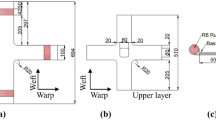Abstract
This paper presents numerical and experimental stiffness characterisation methods for soft composite textile membranes used in fabric roof structures.
The studied material is a polyester plain-woven fabric coated with PVC. We present three numerical textile composite micro-structure models. They are integrated in stiffness calculation software programs which are used to identify linear elastic characteristics for a coated fabric sample. The first two models are based on the laminated thin plate theory; the fabric is represented by a stacking of unidirectionally-reinforced layers, or by the ‘Crimp Model’. The third one considers a geometrical approach to the basic cell of the fabric; the elastic characteristics are calculated by assembly of the meshing elements.
In addition, an inverse and experimental stiffness identification method, based on biaxial tensile tests conducted (in orthotropic directions), is proposed. Load-controlled tests are conducted on cross-shaped samples with different loading ratios in warp and weft directions: 1/1,1/2,2/1.
Résumé
Cet article présente des techniques numériques et expérimentales de caractérisation en rigidité de membranes textiles composites souples utilisées en architecture tensible.
Le matériau étudié est un tissu taffetas en polyester enduit sur chaque face de PVC. Trois modélisations numériques de la microstructure du composite textile, intégrées à des logiciels de calculs des rigidités en élasticité linéaire, sont présentées et appliquées à un exemple précis. Les deux premières ont une approche basée sur la théorie des plaques minces multicouches; le tissue est modélisé soit par une superposition de couches à renforts unidirectionnels, soit par une représentation ondulée (‘Crimp Model’). La troisième considère une approche géométrique de la cellule élémentaire de tissu; les caractéristiques élastiques sont déterminées par assemblage des éléments de subdivision.
En outre, nous proposons une méthode inverse expérimentale d'identification des rigidités des matériaux par l'exploitation de résultats d'essais biaxiaux dans les directions d'orthotropie. La caractérisation expérimentale porte sur des essais de tension biaxiale sur éprouvettes cruciformes, contrôlés en vitesse de montée en charge, et utilisant différents rapports de chargement selon les directions chaîne et trame: 1/1,1/2 et 2/1.
Similar content being viewed by others
References
Mailler, P., Hamelin, P., Jarrigeon, M. and Nemoz, G., ‘Comportement en grandes déformations des matériaux composites souples soumis à un chargement biaxial’, in ‘Annales des composites’, 1995/3, Essais multiaxiaux et composites, Journées AMAC, Besançon, January 1995 (Ed. AMAC).
Zhao, Y.H., ‘Visualisation du champ de déformation de surfaces textiles. Mise au point et utilisation d'un logiciel d'analyse d'image’, Ph.D. Thesis, École Centrale Paris, 1991.
Mailler, P. and Hamelin, P., ‘Methodology of geometrical modeling and theoretical and experimental stiffness characterization: applied to textile reinforced composites structures’, 2nd International Symposium Texcomp-2, ‘New Textiles for Composites’, Leuven, Belgium, May 1994 (Ed. Verpoest and Ko).
Manera, M., Massot, J.J. and Morel, G., ‘Manuel de calcul des composites verre-résine’. (Ed. Pluralis, Paris 1988).
Bonnel, P., ‘Modélisation géométrique et méthodes théorico-expérimentales d'identification des rigidités de composites à renforts textiles’, Ph.D. Thesis, Université Claude Bernard, Lyon I, 1994.
Tsaï, S.W., ‘Composites Design’, 3rd edn (Think Composites, Dayton, USA, 1987).
Ishikawa, T. and Chou, T.W., ‘Elastic behaviour of woven hybrid composites’,Journal of Composite Materials 16 (1) (1982).
Genin, D., Hamelin, P. and Chevalier, Y., ‘Interactions chaînetrame dans les composites renforcés par tissus’, in ‘Comportement des composites à renfort tissus’, colloque du GRECO 92, May 1988, France (Ed. Pluralis 1990).
Peirce, F.T., ‘The geometry of cloth structure’,Journal of the Textile Institute 28 (1937) 81–88.
Bigaud, D., Bonnel, P. and Hamelin, P., ‘TIS3D 2.0: A geometric modeling software for reinforced textile composites’, International Symposium Euromech 334, ‘Textile Composites and Textile Structures’, Lyon, France, May 1995.
De Wilde, W.P., ‘Numerical modelling of linear elastic and viscoelastic response of composite structures’, Vrije Universiteit Brussel, Belgium, 1995.
Author information
Authors and Affiliations
Additional information
Editorial note Prof. P. Hamelin is a RILEM Senior Member.
Rights and permissions
About this article
Cite this article
Szostkiewicz-Chatain, C., Hamelin, P. Numerical and experimental stiffness characterisations applied to soft textile composites for tensile structures. Mat. Struct. 31, 118–125 (1998). https://doi.org/10.1007/BF02486474
Received:
Accepted:
Issue Date:
DOI: https://doi.org/10.1007/BF02486474




